DISCLAIMER: 64 Audio provided me with the A18s in return for my honest opinion. I am not personally affiliated with the company in any way, nor do I receive any monetary rewards for a positive evaluation. I’d like to thank 64 Audio for their kindness and support. The article is as follows.
Throughout the past decade, 64 Audio have cemented themselves as one of the most prominent, go-to in-ear brands in the industry. Professionals and enthusiasts alike have shown endless praise for their build quality and sound, but, really, it’s their band of innovative technologies – from apex, to tia, to 3D-Fit – that’s put them in the position they’re in today. All those pieces came together in their widely-acclaimed flagship A18t. And, now, 64 have come out with its companion. The A18s is a variant of 64 Audio’s 18-driver statement piece with new armatures, a new crossover network and a revamped sound: Levelling off some of the Tzar’s crisp, exuberant clarity for a warm, toned and textured sound made for the stage.

64 Audio A18s
- Driver count: Eighteen balanced-armature drivers
- Impedance: 8Ω nominal
- Sensitivity: 106 dB/mW @ 1kHz @ 1mW (84mV)
- Key feature(s) (if any): tia high driver, apex interchangeable pressure-relief system, 3D-Fit, LID technology
- Available form factor(s): Custom acrylic IEMs
- Price: $2999
- Website: www.64audio.com
Packaging and Accessories
64 Audio ship the A18s in their customary packaging: A compact, red box, sleeved in white, then adorned all around with hi-res prints. This is a more efficient, pragmatic approach to packaging than the more extravagant, boutique stylings of a Vision Ears or Rhapsodio. And, I’m sure there’ll be those out there disappointed by the lack of lavishness here. But, given 64’s massive professional clientele, I can see why, logistically, prioritising efficiency is the approach here. And, despite its supposed simplicity, it does accomplish the crucial task of establishing brand identity and looking clean at the same time.

Unsheathing the box, you’re greeted by a message from company founder and chief sound designer, Vitaliy Belonozhko. It’s a very nice, personal touch. And, flipping it over, you’ll find this in-ear’s quick start guide here too. So, again, efficiency is the name of the game here. Following this is the personalised IEM case, which houses the earpieces themselves, along with their included accessories. With the A18s, you’ll get a shirt clip, a cleaning tool, desiccant and a pair of apex modules as well. The extra set here are the m15’s, while the m20’s come pre-attached on the IEMs. The only accessory I’m missing here is a microfibre cloth for cleaning. But, otherwise, it’s a very complete set packed inside one impressively tight space.

Image courtesy of 64Audio.com
Now, the case I received with my A18s is the one prior to their recent rebrand; the rectangular, plastic one. The new case 64 now include with all their CIEMs is an aluminium, puck-like case. It’s very similar to the ones brands like MMR, Jomo or JH Audio include with a lot of their IEMs. But, where 64’s case differs is the foam inserts. Half the case is taken up by your in-ears with the cable securely tied down, while the lower-half is foam that holds the accessories, complete with slots for additional apex modules. So, you’ll be able to carry them along wherever you go. This foam also secures them all, so they won’t bounce around the case and potentially ding your precious monitors. Lastly, this case maintains the previous one’s water-and-crushproof features. So, all in all, it’s a more compact solution that, I’m sure, feels more premium in hand too.
Customisation, Build and Fit
Personalisation is half the fun when ordering a new pair of CIEMs, and that process is especially easy with 64, because of their superb online builder. It recently got revamped with the launch of their new website and now features a sleeker UI, as well as the use of real-life photography in their previews. This is unlike most other online tools, which use CG renders to preview designs that, in some cases, may differ from the actual product. Aside from choosing your faceplate, shell and artwork, you could also drop in and manipulate any custom graphic you wish to print or engrave onto your IEM. And, the tool also saves all your changes automatically, so you won’t have to start over each time you close your browser window.
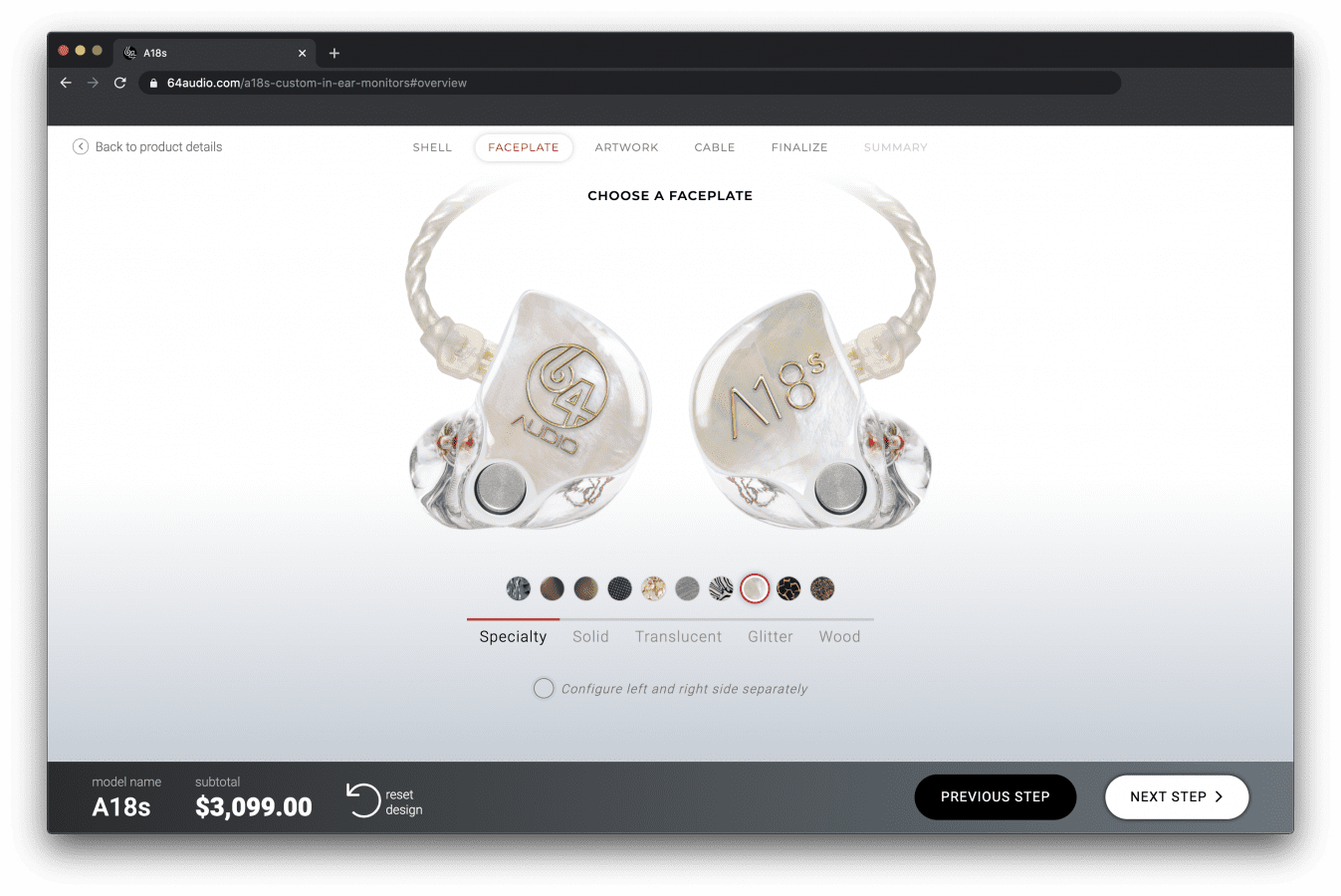
Image courtesy of 64Audio.com
The personalisation options you get from 64 Audio are fairly diverse. You have a total of 54 faceplate styles ranging from solid, translucent and glittered colours to more exotic materials like wood, carbon fibre, rose gold and abalone. You may also opt for add-ons like watch parts and rhinestones, or simply top off your IEM with 64’s metallic logos in silver or gold.
Unfortunately, that diversity won’t extend to their shell colour options, which – as a result of their 3D production process – is limited to a set of 5. Now, this isn’t ideal when many in the industry have begun offering multi-coloured swirls, with a few going as far as CNC-milled wood and carbon fibre shells (albeit, for a very hefty cost). But, again, this is necessary for 64’s current scale and clientele. And, there are plenty of other options in the market if aesthetics mean massively to you.
Another change 64 have recently included is the option to choose between 2-pin and IPX connectors. The IPX standard is pretty recent, and it’s designed specifically for touring musicians. It’s tailor-made for reliability, and it features resistance against water, dust and sweat. It is also a swivelling connector, which allows you to reposition your IEMs if you ever need to. And, it is rated for more plugs and unplugs than the 2-pin standard with an easier, more tactile swapping system too.
The disadvantage is in its newness. It’ll be more difficult to find replacements for IPX-equipped cables on the fly, while 2-pin-equipped ones are easier to procure. And, for audiophiles who’ve already collected a fair number of 2-pin cables, an adapter or permanent retermination will be required to use those cables with your new 64 Audio in-ears. So, if you’re an audiophile with an extensive upgrade-cable collection, and you won’t need IPX’s added reliability, 2-pin would still be my recommendation. But, if you are a working musician, IPX is the choice for ultimate convenience, reliability and durability.

As far as build, fit and finish go, 64 Audio continue to deliver with their custom in-ears. My A18s’s are flawless all around, and they air a level of polish indicative of 64’s stature in the industry. Their 3D-printed shells are among the clearest I’ve seen; not necessarily as pristine as a poured-acrylic one, but unquestionably top-class among its peers. That allows for a good glimpse into the in-ear’s innards, which, despite its immense complexity, 64 have managed to keep very admirably organised. From here, you can also see the tia tweeter in its tia bore, equipped with a mesh filter to keep out any debris.
For the faceplates, I opted for 64’s mother-of-pearl, which I think turned out sublime. They’ve cleverly inlaid this material over a base of white acrylic, which gives it a bit of substance and enhances its clean, pristine, angelic look. Like the shells, every bit of machining on it is pin-point precise. Its joint with the body is seamless and without a trace of glue or residue. And, the same goes for the apex port at the bottom of the faceplate. In fact, compared to my previous 64 Audio customs, I’ve found these to be the easiest in terms of swapping out apex modules. Whether this’s down to a slight change in their specs or pure, dumb luck, I’m not sure. But, it’s a positive either way. And, lastly, topping off the faceplates are 64 Audio’s gold-metallic logos. As usual, I adore the detail on them, as well as the slight 3D-effect they give off; a true cherry-on-top.
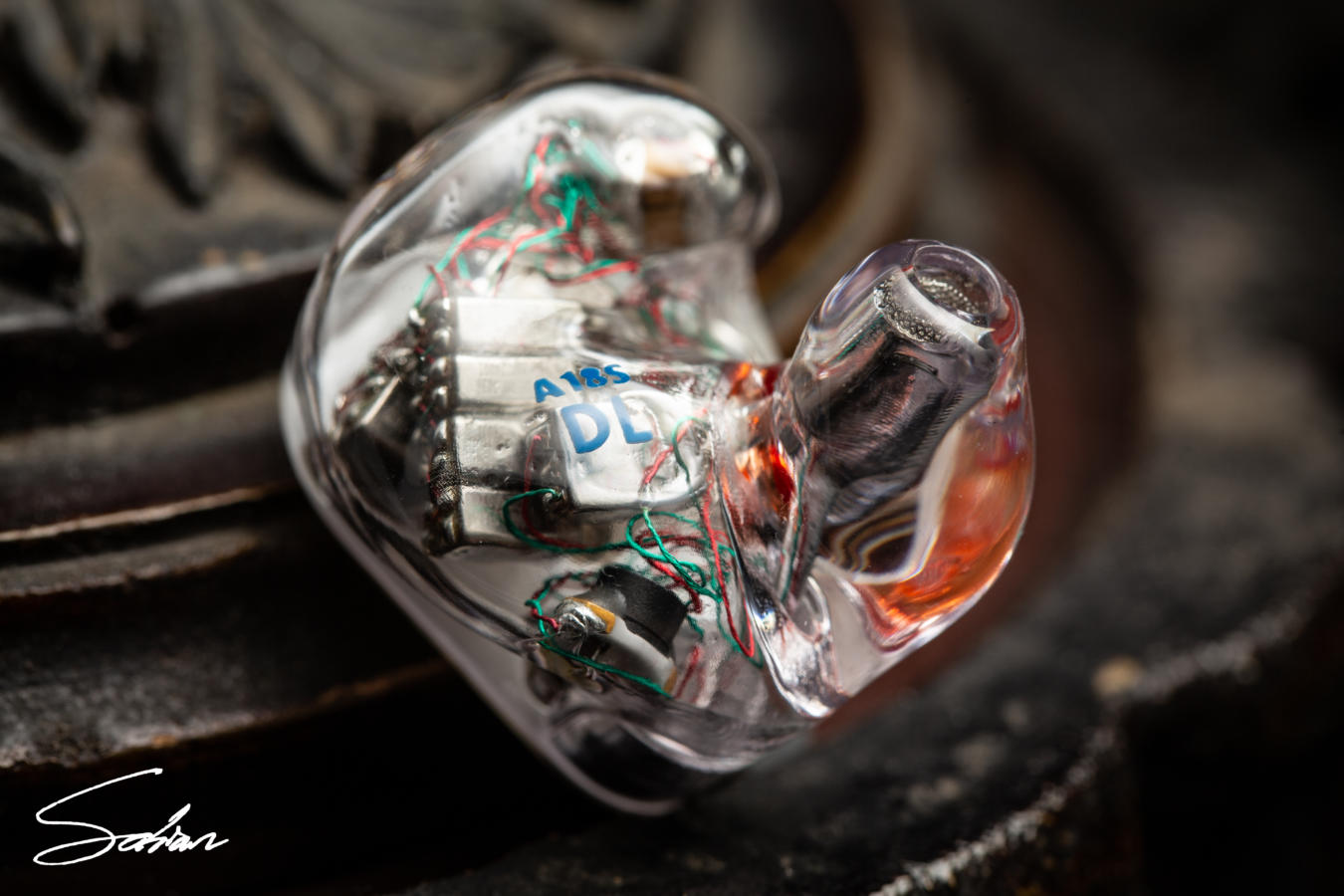
Finally, moving onto fit, the A18s joins its 64 Audio brethren as one of the most secure, precise-fitting custom IEMs in my collection. The company’s 3D-Fit tech (which we’ll discuss below) has proved key in preserving as much detail as possible from the original moulds, resulting in earpieces that simply lock into my ear canals and – crucially – don’t slosh around in use. This’s a big plus for artists with lots of high-energy choreography, or performers who move a lot on stage in general.
Now, with my 64 Audio A6t and A18t, that trimming style did result in a bit of tightness, especially in their initial few days of use, or if I’m going to them from a looser-fitting CIEM. To my pleasant surprise, that was not the case with this A18s. It had a slightly more relaxed fit without losing any of 3D-Fit‘s accuracy. And, the smaller faceplates helped relieve pressure on the outer ear too. To me, this is 64 continuing to refine their craft, and their reward is a perfectly-seated custom IEM.
What’s New?
Though the A18s largely builds off of the A18t’s design and sound signature, with it comes a good number of changes as well. Among them would be the balanced-armatures themselves. Although the number stays at 18, this A18s sports new driver models in its set. Then, paired with them is a new, more sophisticated crossover network. The two are responsible for the in-ear’s warmer tonality, which we’ll discuss in sound impressions and comparisons on the following pages. Then, also thrown into its signal path is LID tech. It’s one of 64’s many proprietary technologies, which we’ll now discuss below.
tia
64 Audio claim the conventional method of sound transfer – which entails a driver firing through its spout into tubes and dampers – results in resonances that’ll reduce transparency and resolution. Their remedy to this is a system called tia (or Tubeless In-Ear Audio), which cuts those tubes and dampers out of the equation, and has the driver fire straight down the ear canal. In addition, the driver has been de-lidded, so instead of firing through a tiny spout, its diaphragm is now freely radiating for what 64 claim will create higher fidelity, a more expansive soundstage and a smoother frequency response.

Image courtesy of 64Audio.com
Now, the second element to this system is what 64 call the tia single-bore. It houses the tia driver and acts as an acoustic chamber, shaping its sound to deliver a “linear and coherent frequency response.” What it also does in the custom tia in-ears is compensate for the inherent variances in volume from one ear canal to the next; even within the same individual. By setting-in-stone the room in which the speaker will radiate, it allows for a consistent frequency curve from one A18 to the next and minimises unit variance as much as possible. Lastly, this design is also less likely to clog with wax over time.
apex
apex has been 64’s hallmark innovation for years now, and what it is is a valve that releases built-up pneumatic pressure from your ear canal. This pressure accumulates when the drivers pump air in your ear canal to generate sound, and that air has nowhere to escape. And, it will eventually lead to listening fatigue. So, through apex, 64 have created a controlled leak, allowing air to travel freely and the ear drum to breathe properly. This should greatly delay the onset of fatigue and lend the user sharper focus for longer periods of time, crucial for musicians or engineers who perform for hours on end.
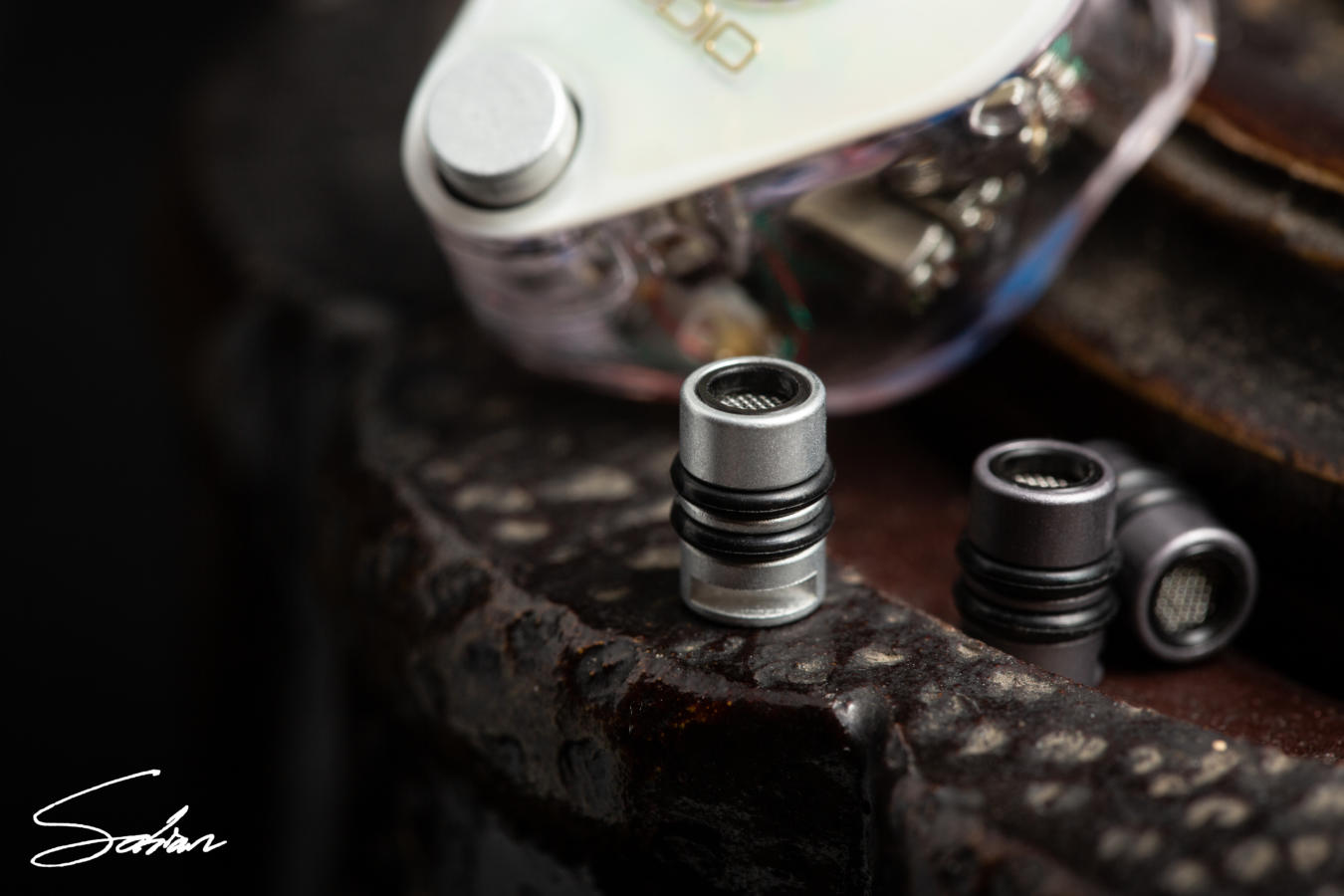
A secondary function of apex is customisation in terms of the monitor’s bass response and noise isolation. The light-grey m20 provides -20dB of isolation and is default for the A18s’s tuning, while the dark-grey m15 provides -15dB of isolation, along with a slight bass cut, which we’ll further discuss in sound impressions. While neither of them will match the -26db isolation most non-apex monitors claim on their specs sheets, I personally found both apex modules perfectly adequate for daily use, and even behind a loud instrument like the drum kit. But, if you are particularly picky about isolation, 64 do offer an m26apex module, which disables all apex functionality and provides the industry-standard -26dB of isolation.
3D-Fit
3D-printing has grown widespread in this in-ear monitoring industry, and 64 were one of its first adopters. Its integration into their manufacturing process has allowed for a number of advantages. Trimming ear moulds digitally on a computer enables a finer degree of control. And, it’s a non-destructive method, so any error made during cutting could be undone.
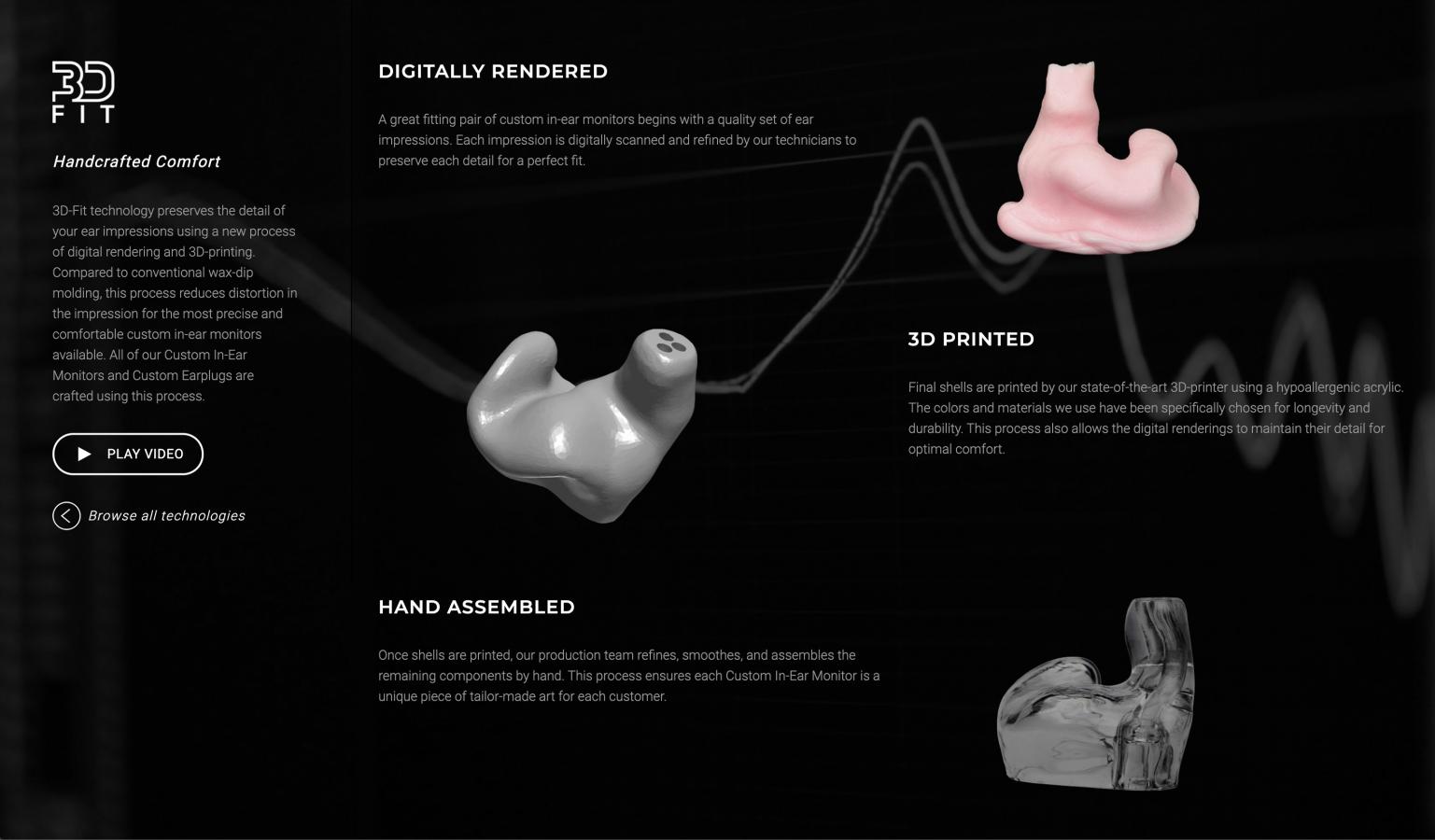
Image courtesy of 64Audio.com
64 claim their digital processing also preserves more of the ear canal’s fine details, while the traditional method of hand-trimming and wax-dipping could smooth some of these nuances over. And, digital moulds can also be reused with future orders, which’ll save time and money from having to send new ones over. While physical moulds can similarly be reused, they will inevitably deteriorate, which can cause a poor fit if the mould is too old. Digital moulds won’t have this shelf life.
Lastly, apart from those comforts, 3D-printing is crucial for fabricating the components in all of the acoustic technologies mentioned above. It allows the in-ears’ shells to be printed with the indent for the 2-pin socket, the tia bore and the apex socket all built-in, ensuring them consistent, reliable machining and exponentially streamlining their production process.
LID Technology
LID (or Linear Impedance Design) Technology is 64 Audio’s solution to source variance with multi-driver in-ears. Within the 18 in this A18s are several models of balanced-armature drivers, each with their own unique impedance curve. Because of that, the monitor’s frequency response (or tonal balance) can wind up shifting between different sources (i.e. portable players, mixing consoles, mic packs, etc.), based on how each driver set reacts to that source. LID’s role is to compensate for those discrepancies, so the balanced-armatures are driven equally by the source and the original sound is preserved.
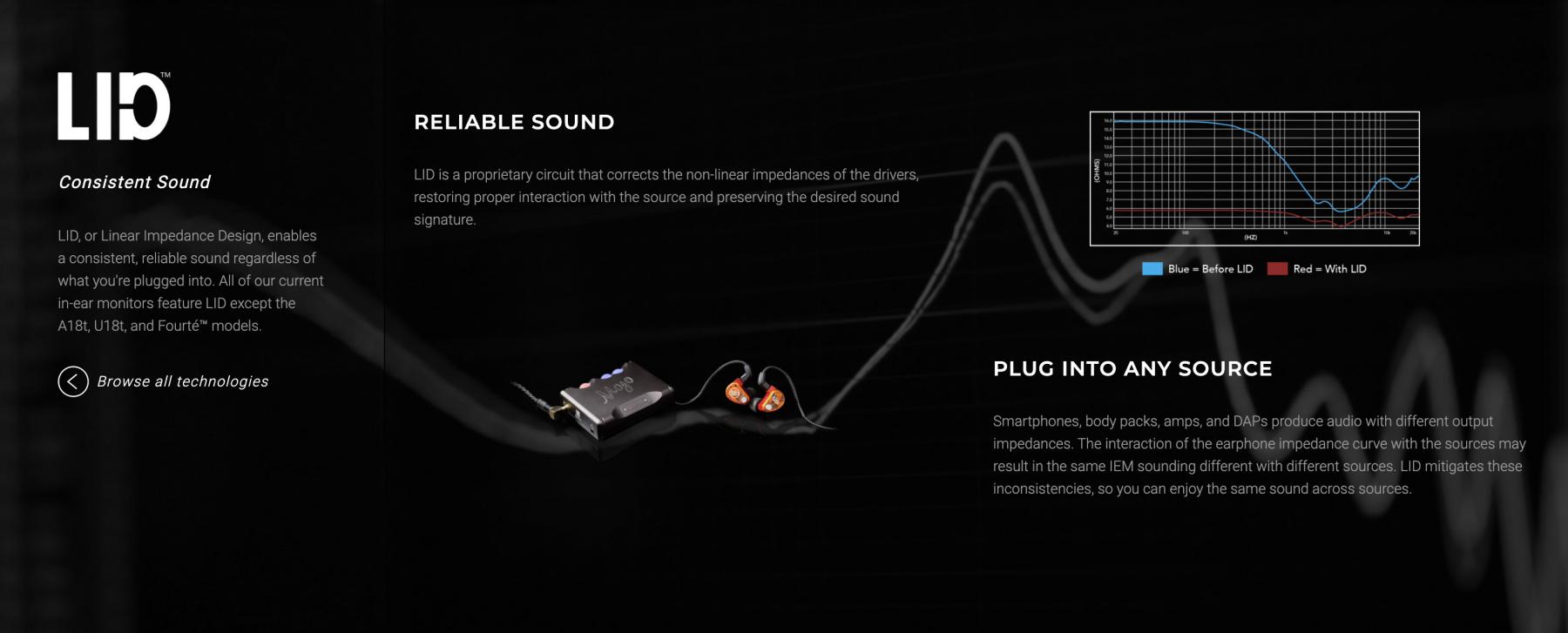
Image courtesy of 64Audio.com
This is a feature that’ll prove valuable to, for example, sound engineers like myself, who use in-ears with sources ranging from enthusiast’s portable players, to AVIOM monitoring systems, to noisy headphone outputs on a mixing console. But, for the enthusiast, I can see it falling between two camps. There’ll be those relieved by this A18s’s “immovable” sound, as they won’t have to worry about what source to pair with it. On the other hand, there’ll also be those who’d feel limited by the fact that they won’t be able to customise the in-ear’s profile with their selection of sources. But, the A18s is a monitor designed with pros in mind, after all. So, in that sense, I do think LID can be a great asset and a godsend to any engineer.


